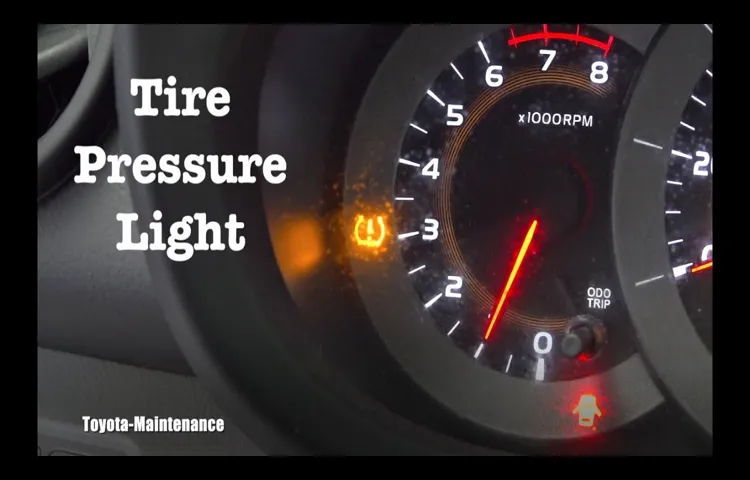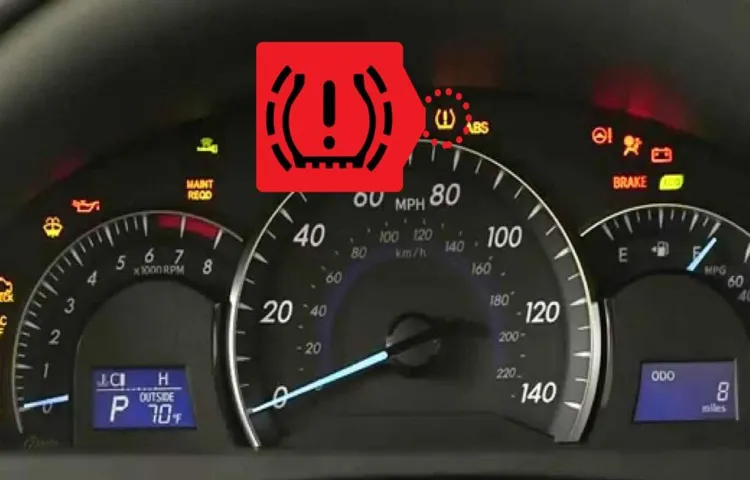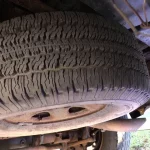Do you ever feel overwhelmed when it comes to checking your tire pressure? It can be a daunting task, but it’s crucial to maintain your vehicle’s safety and performance, especially with a car like the Toyota Camry. The Toyota Camry is a reliable, fuel-efficient sedan that’s known for its smooth ride and practicality. However, even the best cars need proper tire maintenance to avoid accidents and ensure optimal gas mileage.
Therefore, understanding Toyota Camry’s tire pressure requirements is essential to keep your vehicle in top shape. In this blog, we’ll dive into everything you need to know about Toyota Camry tire pressure and how to maintain it effectively. So buckle up and join us on this informative ride!
Table of Contents
Why Proper Tire Pressure is Important
If you drive a Toyota Camry, then you might be wondering what the recommended tire pressure is. The answer depends on the year and model of your vehicle, but generally, the tire pressure for a Toyota Camry should be between 30-35 PSI (pounds per square inch). It’s important to keep your tires inflated to the recommended level because the right tire pressure provides numerous benefits, including better fuel efficiency, improved handling, and longer tire lifespan.
Underinflated tires can cause your car to use more gas, lead to poor handling, and increase the risk of accidents. On the other hand, overinflated tires can wear out faster and make your ride uncomfortable. To ensure that your Toyota Camry performs optimally and stays safe on the road, it’s essential to check your tire pressure regularly and maintain the recommended level.
Fuel efficiency and safety
Proper tire pressure is crucial when it comes to fuel efficiency and safety. When tires are underinflated, they create more rolling resistance and require more energy to move your car. This means your engine will have to work harder, consuming more fuel and producing more emissions.
On the other hand, overinflated tires can reduce your car’s handling and stability, making it more prone to skids and crashes. Additionally, they can cause the vehicle to bounce excessively, leading to an uncomfortable ride. Therefore, it’s important to regularly check your tire pressure and ensure it’s within the recommended range.
By doing so, you can reduce your fuel costs, minimize your carbon footprint, and, most importantly, keeps you and your passengers safe on the road. So next time you fill up your gas tank, take a few extra minutes to check your tire pressure and ensure it’s properly inflated. It could go a long way in improving your car’s performance and your overall driving experience.

Finding the Recommended Tire Pressure
When it comes to maintaining your Toyota Camry, one essential aspect to keep in mind is the tire pressure. The recommended tire pressure for a Toyota Camry can vary depending on the specific model and year. Generally, it is suggested to maintain a tire pressure between 30-35 PSI.
It is crucial to check the tire pressure regularly, as over-inflated or under-inflated tires can create an unsafe driving situation. Over-inflated tires may cause the vehicle to feel “bouncy” while driving, and under-inflation can lead to decreased fuel efficiency and make the car more challenging to control. It is recommended to check the tire pressure at least once a month and before long road trips.
You can find the correct PSI for your Toyota Camry in the owner’s manual or on the tire placard located on the driver side door jamb. Keeping your Toyota Camry’s tires properly inflated will not only ensure a safer driving environment, but it will also increase fuel efficiency and prolong the life of your tires.
Owner’s manual and tire placard
Finding the recommended tire pressure is essential for maintaining optimal driving performance and safety. Your car’s owner’s manual and tire placard are the two primary sources of information needed to determine the recommended tire pressure. The tire placard is typically located on the driver’s side doorjamb, and it provides important details about the manufacturer’s recommended tire size, load capacity, and inflation pressure for both front and rear tires.
It is important to note that the recommended tire pressure may vary depending on different factors, such as the tire type, driving conditions, and vehicle load. Therefore, it is crucial to refer to the owner’s manual for more specific information and guidelines. Keeping your tires properly inflated will not only improve your car’s handling and fuel efficiency but also extend the lifespan of your tires, maximizing your investment.
So the next time you hit the road, don’t forget to check the recommended tire pressure according to your vehicle’s owner’s manual and tire placard before driving off!
Recommended Tire Pressure for Toyota Camry
As a proud Toyota Camry owner, you may wonder what the recommended tire pressure should be for your vehicle. The ideal tire pressure for the Toyota Camry varies depending on the model year and tire size. However, typically, the recommended tire pressure will be listed in the owner’s manual or on the inside of the driver’s side door.
A general rule of thumb is to keep the tire pressure between 32 and 36 psi. Proper tire pressure is important because it ensures that the tires are making the correct amount of contact with the road, which results in better traction and handling. Additionally, maintaining the appropriate tire pressure can extend the life of your tires and improve fuel efficiency.
Monitor the tire pressure regularly and adjust it as necessary to keep your Toyota Camry running smoothly and efficiently.
Specific tire sizes and trims
If you own a Toyota Camry, you may be wondering what the recommended tire pressure is for your specific make and model. The answer depends on the size of your tires and the trim level of your Camry. For example, if you have a base model Camry with 16-inch tires, the recommended tire pressure is 32 psi for the front tires and 30 psi for the rear tires.
However, if you have a Camry XSE with 19-inch tires, the recommended tire pressure is 35 psi for the front tires and 33 psi for the rear tires. It’s important to note that following these recommended tire pressure levels not only ensures optimal performance, but also helps with fuel efficiency and safety on the road. So, the next time you take your Camry on a long road trip or just for a quick drive around town, make sure to check the tire pressure and adjust accordingly.
Your Camry will thank you for it.
How to Check and Adjust Tire Pressure
If you’re wondering what the tire pressure should be on your Toyota Camry, the answer will depend on the specific model year and tire size. Typically, the recommended tire pressure for a Camry will range from 30 to 35 PSI (pounds per square inch). It’s important to check your tire pressure regularly, as both over-inflation and under-inflation can lead to issues like reduced gas mileage, tire wear, and even blowouts.
To check your tire pressure, start by using a tire pressure gauge to measure the PSI in each tire. If your tires are over-inflated, release some air until they reach the recommended PSI. If they’re under-inflated, add air until they reach the recommended level.
It’s also a good idea to adjust your tire pressure in response to any weather changes or if you’re carrying extra weight in your car, as these factors can affect tire pressure. By keeping your tires properly inflated, you’ll not only promote better tire health and longevity, but also ensure optimum vehicle performance and safety.
Using a tire pressure gauge and air compressor
Checking your car’s tire pressure regularly is an essential part of maintaining your car’s good condition and ensuring your safety on the road. To check your tire pressure, you’ll need to use a tire pressure gauge, which is a small device that measures the air pressure inside your tire. Simply unscrew the valve stem cap on each tire, place the gauge’s nozzle onto the valve stem, and press down to obtain a reading.
If the pressure is too low or too high, you’ll need to adjust it accordingly using an air compressor. Using an air compressor can seem daunting, but it’s a fairly straightforward process. Begin by parking your car close to the compressor, connect the hose to the compressor’s outlet valve, and attach the tire chuck to the valve stem.
Once connected, turn on the compressor and fill the tire with air until you reach the desired pressure level, which can be found in the owner’s manual or on a sticker located on the driver’s side door. By checking and adjusting your tire pressure regularly, you’ll not only extend the lifespan of your tires but also improve your car’s fuel efficiency and handling abilities. So don’t neglect this important maintenance task and keep your car in tip-top shape for the road ahead!
Maintaining Proper Tire Pressure
Maintaining proper tire pressure is crucial for the safety and longevity of your Toyota Camry. The recommended tire pressure for a Toyota Camry varies depending on the model and year, but it is typically between 30-35 PSI (pounds per square inch). Keeping your tires inflated to the correct pressure will improve your vehicle’s fuel efficiency, traction, handling, and overall performance.
It will also reduce the likelihood of a blowout or premature wear and tear on your tires. To ensure you are maintaining the proper tire pressure, check your tire pressure at least once a month, and always before long trips. You can find the recommended tire pressure for your specific Toyota Camry in the owner’s manual or on the driver’s side door jamb.
It’s essential to never overinflate or underinflate your tires, as both can negatively impact your car’s performance and safety. By taking the time to properly inflate your tires, you can ensure a smooth and safe driving experience in your Toyota Camry.
Regular checks and adjustments
Maintaining proper tire pressure is crucial for keeping your vehicle safe and running smoothly. Regularly checking and adjusting your tire pressure can extend the life of your tires, improve fuel efficiency, and even enhance your overall driving experience. When tires are underinflated, not only does it increase the risk of blowouts and accidents, but it can also lead to uneven wear and tear on your tires.
On the other hand, overinflated tires can reduce your vehicle’s stability and traction on the road. To prevent these issues, it’s important to check your tire pressure at least once a month and adjust it according to the manufacturer’s recommendations. Whether you use a manual or digital tire pressure gauge, a quick check can save you from potential headaches down the road.
So, take care of your tires, and they’ll take care of you on your next adventure!
Final Thoughts
When trying to determine what the tire pressure should be on a Toyota Camry, there are a few things you should consider. Firstly, it’s important to remember that the ideal tire pressure will vary depending on the make and model of your vehicle, as well as the type of tires you have on it. In general, the recommended tire pressure for a Toyota Camry is around 32-35 psi, but it’s always a good idea to consult your owner’s manual or speak to a professional to ensure you’re using the right pressure for your specific vehicle.
Keeping your tires inflated to the right pressure can help improve your car’s handling, fuel efficiency, and overall performance, so it’s definitely worth taking the time to make sure you’re getting it right. By doing so, you can extend the life of your tires and help keep your vehicle running smoothly for years to come.
Conclusion
In the world of Toyota Camrys, the question of tire pressure can be a tricky one. Much like a Goldilocks-style dilemma, the pressure can’t be too high or too low, but rather, it must be just right. Too high and you risk a bumpy and uncomfortable ride, too low and you’re inviting a flat tire.
So, what’s the magic number? Well, it ultimately depends on the make and model of your Camry, but as a general rule of thumb, aim for the recommended pressure listed in your owner’s manual or on the sticker inside your car door. Remember, a properly inflated tire not only provides a smooth ride, but it can also save you money on gas and prevent unnecessary wear and tear on your vehicle. So, don’t let the pressure get to you – check those tires and keep on rollin’!”
FAQs
What is the recommended tire pressure for a Toyota Camry?
The recommended tire pressure for a Toyota Camry is usually around 32-35 psi.
How often should I check the tire pressure on my Toyota Camry?
It is recommended to check your Toyota Camry’s tire pressure at least once a month or before long trips.
Can overinflating or underinflating my Toyota Camry’s tires cause damage?
Overinflated or underinflated tires on your Toyota Camry can cause uneven wear, reduced fuel efficiency, and even tire failure in extreme cases.
What happens if I drive on underinflated tires on my Toyota Camry?
Driving on underinflated tires on your Toyota Camry can result in poor handling, tire damage, decreased fuel efficiency, and potential blowouts.
What tire brands are recommended for a Toyota Camry?
There are many tire brands that are recommended for a Toyota Camry, including Michelin, Bridgestone, Goodyear, and Continental.
Can I rotate my Toyota Camry’s tires?
Yes, it is recommended to rotate your Toyota Camry’s tires every 5,000-7,000 miles to ensure even wear and prolong tire life.
What should I do if my Toyota Camry’s tire pressure monitoring system (TPMS) light comes on?
If your Toyota Camry’s TPMS light comes on, you should check the tire pressures and inflate or deflate them to the recommended pressure. If the light stays on, there may be a malfunction with the system and you should have it checked by a professional.



